Introduction
It is at least half an hour’s drive to the forest where you and your hunting friends search for deer. Tonight, a buck appears from the North at exactly 18:45 with its stance hesitant and highly alert. However, it has grown too dark to resume observing the animal through your 8×20 pocket binoculars. So, you set them aside and grab a larger pair of low-light binoculars, which you bought with the help of this ULTIMATE Low-Light Binoculars Buying Guide.
First to be mentioned are the general features of low-light binoculars, so you become familiarized with the basic features. Then, we laid down the most common fields of use, so you know where and when to use them. By the end, you will know what to look for, the only thing left is the price, so we arranged categories of low light binoculars in terms of price, along with some benefits, as well as the drawbacks.
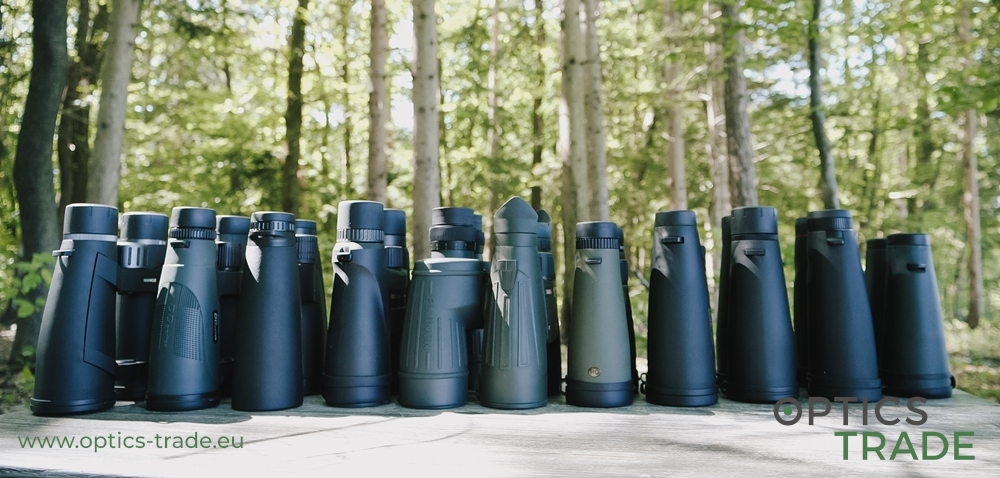
If you have any additional questions regarding low light binoculars or any optical device from the field of sport optics, send an e-mail to info@optics-trade.eu. As a team of passionate sports optics enthusiasts, we are always glad to help.
General Features
In Europe, hunting during the magic hours of twilight is extremely popular. This is the time of day when animals come out of hiding due to the restlessness of the day. So, the best time to hunt is oftentimes also the worst time to see. Since hunters can recall, optics from premium brands have been known to produce optics that work best in low-light situations.
In general, low-light binoculars sport an exit pupil of around 7 mm, which is the maximum value the human eye can use. Low light binoculars usually prove to be on the heavier side, that is around 1 kg or more, and large as well.
The magnification these binoculars most often feature is a 7x or 8x magnification, sometimes even 9x. Do keep in mind, though, that higher magnification means smaller exit pupil, so we see a dimmer image in the dusk – which is the opposite of what we want. Our recommendation would be to choose binoculars with an 8x magnification.
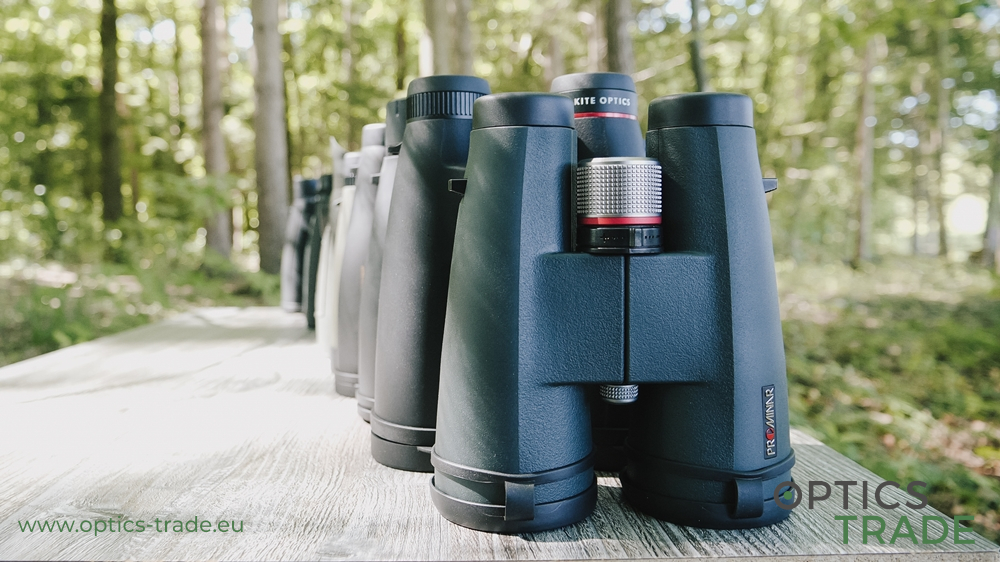
When in low light, as noted, it takes time for the eyes to adjust, so dropping the binoculars into the water because of the dark is more common than one might think. But no need to worry, as low-light binoculars are waterproof. They also feature a shockproof and fog-proof body that gives you peace of mind when taking them out into the bush. What does the term ‘fog-proof’ even mean? When binoculars are exposed to extremely low temperatures and high levels of humidity, the lenses tend to fog up, which results in unclear observations. To prevent this issue, manufacturers purge the binoculars with gas, usually argon or nitrogen.
The biggest breakthrough when it comes to low light use has actually been the usage of glass coatings for an improved light transmission rate because not only do we have to see it to believe it, we also have to see it to accurately shoot it.
The Importance of the Exit Pupil
To achieve the best results, the exit pupil diameter must be as big as the pupil can widen. In ideal conditions, our pupils can dilate up to 7 mm. Thus, all manufacturers thrive towards producing binoculars with an exit pupil as close to 7 mm, so the user can see the brightest image possible. However, creating an exit pupil bigger than 7 mm would be unnecessary.
The exit pupil is important because the image the binoculars provide is as bright as the amount of light the eye can receive. And with almost everything, this ability decreases with age, so older people can choose an 8×50 or 8×42 magnification in order not to carry such heavy binoculars and still see a bright enough picture.
The exit pupil diameter can also be calculated with a simple math formula of dividing the lens diameter specification with the power of the magnification.
Left to right: Blaser Primus 8×56, Zeiss VictoryHT 8×54 and Swarovski SLC 8×56
Low Light Binoculars Configurations
8×56 is the ideal configuration to be used with low-light binoculars, as the 56 mm objective lens gathers a large amount of light, and the combination with an 8x magnification provides an exit pupil diameter of precisely 7 mm, which is perfect for the human eye. Here are some others:
- 8×56 is used with Porro and roof prisms, and it has a 7 mm exit pupil
- 7×50 is used with Porro prisms, and it has a 7,14 mm exit pupil
- 9×63 is used with roof prisms, is extremely rare, and it has a 7 mm exit pupil
- 7×42 is used with Porro and roof prisms, and it has a 6 mm exit pupil
Prisms on Low Light Binoculars
Porro prisms, named after the inventor Ignazio Porro, have always been considered a wonderful choice for low-light binoculars, as they have an excellent light transmission rate. However, roof prisms of the Abbe-Koenig type, named after the inventors who worked on the development of prisms at Zeiss, proved to be better when we tested the binoculars in low light. What the testing also showed is that Schmidt-Pechan roof prisms are not suitable for low-light use.
Hunters will also appreciate the fact that both prism types can be used in low-light situations, as well as on water, but binoculars specifically made for marine use usually have Porro prisms. The style of Low Light Binoculars with Porro prisms is the same today as it was 20 years ago. As mentioned, this type of binocular offers excellent light transmission. Most often, their focus is separated for each eye.
Porro prisms are valued mostly due to the outstanding water tightness and because they are also affordable and would not cost you an arm and a leg. The downside is that Porro prisms are remarkably large and therefore also heavy and not as comfortable as binoculars featuring a Roof prism. Today, the Abbe-Koenig prism is the trending prism used with low-light binoculars, as ergonomics, as well as light transmittance, are excellent.
Oftentimes, Abbe-Koenig binoculars are larger with longer barrels but are still somewhat more lightweight than Porro binoculars. However, they are sold at a higher price and do not offer such a wide range of options, as only Zeiss, Noblex (used to be Docter), and Swarovski are producing them. And after testing the binoculars in the field, we came to the conclusion that Abbe-Koenig prism binoculars perform slightly better in low light when compared to Porro prism binoculars from the same price range.
Left to right: Delta Optical Titanium 8×56 ROH, Delta Optical Extreme 7×50 ED and Steiner Observer 8×56
The Focusing System on Low Light Binoculars
Most binoculars for low-light use have central focusing, which sometimes proves to be difficult to operate in low-light situations, as it is not that simple to focus. But more effort oftentimes leads to better results. There is a belief among hunters that binoculars with focusing separated for each eye are better. After testing the optics, this belief was debunked. Yes, individual focusing immediately results in a sharp image when first looking through the binoculars, but, when comparing central and individual focusing on binoculars from the same price range, the image can be even sharper after adjusting the central focusing on low-light binoculars.
Light Transmission Rate
Light transmission rate refers to the amount of light that passes through a pair of binoculars, or any other optical device. The result tells us how well the binoculars perform in low light – anything higher than 80% is decent, and anything higher than 90% is excellent. In order for the results to be depicted accurately and realistically, they should be presented in a graph, and not in the form of numbers.
Manufacturers can manipulate the numbers and how well a pair of binoculars performs in poor light conditions by providing the users with the numbers, instead of showing them a graph. Some companies point at the highest point in a graph and mark it as the light transmission rate, which is misleading. In order for binoculars to perform well in such lighting conditions, the light transmission should be great below 550 nm of wavelength. Why? Because everything above this wavelength is insignificant – the human eye cannot recognize warm colours at night.
Also, companies should calculate the value of all lenses combined, and not just one. Contrast is really important when it comes to low-light performance as well. What should also be noted is the fact that a pair of binoculars can have a high light transmission rate value, but if the diminishing of internal reflections is poor, then so is detail rendering. This is because your eyes then obtain a lot of useless light with few details. To avoid such marketing tricks, we tested the binoculars ourselves and created our own assessment.
Source: Zeiss
Fields of Use
Since all binoculars look pretty much the same, it is easy to assume that they can all be used in a similar manner. The truth of the matter is that such is not the case, as the name itself suggests that these binoculars work best in low-light conditions. Surely, they can be used elsewhere, but if you are a hiker or want to take your binoculars on a cycling trip, pocket or compact binoculars might be a better option because they are not as heavy. It would be almost impossible to take a giant telescope on a hike, but the case with binoculars is, they can be used for everything – some just work better under certain circumstances.
Because everyone is talented in their own way, we suggest bird watchers, hikers, or simply nature enthusiasts searching for a pair of binoculars for this type of use, to also read our other buying guides. But if you wish to hunt during twilight or merely to use low-light binoculars, you have come to the right place.
Left to right: Zeiss Conquest HD 8×56, Kahles Helia 8×56 and Steiner Nighthunter 8×56
Yes, low-light binoculars are mostly used for hunting – but not all types, as their usage is extremely specific. These optics are of use only in situations where a hunter benefits from a bright image of the target. This is exclusively the case when hunting at dusk when the lighting is bad. Low light binoculars, however, are not the best option for stalking, driven hunts, or any other type of hunting where there is a lot of movement.
We would not put low-light binoculars on our list of top picks for birdwatching or hiking. Why? Because they can be heavy, bulky, and large. Due to their big lenses, the whole design is big, so it is difficult to store them even in your backpack – a nightmare for hikers – they can benefit more from other types of binos. The usage is extremely comfortable, as they have a generous eye-box and eye-relief. But, when observing for longer periods of time, their weight can become a problem.
Low Light Binoculars Vs Thermal Optics
In the past 5 years, thermal optics have slowly been appearing and challenging low-light binoculars. But how do they compare? Price-wise, they are extremely similar. About five years ago, however, this was not the case. Thermal optics was extremely expensive, and you could not get a hold of it for less than 2000 €. Over the years, thermal optics has been undergoing improvements, and surprisingly, the price has also been dropping.
In March 2021, the cheapest thermal imaging monocular can be bought for 550 €, but for a device with slightly better quality, try not to go lower than 1000 €. The advantage of thermal optics is that hunters can also see animals hiding in the forest and can notice them immediately due to their detection range. Thermal optics are most often smaller and more lightweight, which is always a plus.
Both thermal optics, as well as low-light binoculars, are not only night owls, as they can also be used during the day. However, low-light binos have the upper hand when it comes to recognition and assessment. Through them, the observer can also see more detail, such as antlers on a deer, and because they do not tire the eyes, low-light binoculars are extremely comfortable to use.
How the Testing Was Done
We tested a large number of low-light binoculars. The testing was done by the Optics Trade team, by those who encounter optics on a daily basis (the sales and marketing team), and those who do not (the logistics and the accounting team). By inviting our colleagues from different sectors of our company, we wanted to obtain results that are as least biased as possible.
First, we ranked them according to the price and began with the testing of the most affordable pair. We always tested two binoculars at once and decided which of the two performed better in low light. The winning optics then got paired up with the next one on the price scale. All binoculars were paired up at one point, even the one which performed the worst with the one which performed the best.
This process was repeated until there was the last one standing and until we created our personal assessment. What did we take into account? Our main concern was the purpose of these binoculars – which is how do they perform in low light – in other words, to what extent can we still see the details of the image.
Price Classes
Below 500 €

Left to right: Delta Optical Extreme 7×50 ED and Steiner Observer 8×56
At this price range, it is unreasonable to expect a pair of binoculars that offer outstanding optical performance. Low-light binoculars are, out of all optics, the most difficult to produce, so they take the most effort and money. If you decide on buying entry-level low-light binoculars, our advice is to not spend less than 300 € on them.
When it comes to entry-level binoculars, they usually sport eyepieces that can be adjusted in two or three different positions. From 300 € onward, all of them are purged with nitrogen or argon, to prevent internal fogging at low temperatures – most binoculars over 300 € are also waterproof.
The price is lower as binoculars or at least their components are manufactured in China, whether this is where their factory is based or not. Among low-light binoculars in this price range, we can find models made with roof as well as Porro prisms.
All optical surfaces have coatings, but they are not the same high quality as on the more costly low-light binoculars. Most of them have aluminium housings, except the notably cheap ones, as their housing is made of plastic. Usually, the companies offer a 2-year warranty, some even 5, which is not a lot, so do try to keep your new optics away from any trouble.
Our picks
When tested, Steiner Observer won us over, however, Delta is still among the best buys because it is cheaper, but both beat all other low-light binoculars for this price.
Delta Optical Extreme 7×50 ED
Something of a bargain, Delta Optical Extreme 7×50 ED binoculars are extremely well-built for this price range but big and heavy at the same time (1620 g). To some, these China-made binoculars resemble the famous Fujinon 7×50 FMTR-SX-2, which is an advantage. Delta Optical Extreme comes in an interesting brown colour, which is quite unusual in the world of sport optics, but we are here for it.
The binoculars have focusing separated for each eye, paired with a bright and sharp image of high quality, especially for this price. The field of view is also very wide. The objective lens covers are attached to the housing, which is excellent for those who like to misplace them regularly. These quality-rubber binoculars also have good elimination of chromatic aberration for the price. The image can be a bit yellow, the edge sharpness is not the best, but this is expectable for such a low price.
Delta Optical Extreme 7×50 ED
Pros
- extremely well-made for the price
- waterproof
- good solution for the flip-up covers
- wide field of view
Cons
- very big and heavy
- close focus distance
- a slightly yellow image
- edge sharpness
Steiner Observer 8×56
Steiner Observer 8×56 are Schmidt-Pechan roof prism binoculars perfect to take out at night when in search of Bambi. At an affordable price, these binoculars offer something that is well protected with excellent ruggedness and bright and clear images. These Observer binoculars are also one of the few with the 8×56 configuration for such a low price.
The appearance of the Steiner Observer 8×56 binoculars might not suit everyone, but most hunters love them because they sport a unique design that appeals to hunters. Observer binoculars are extremely robust and have excellent build quality but are lightweight at the same time, which is helpful, especially if your target animal likes to play hide and seek.
Their armouring features durable rubber, as every hunter needs a durable pair of binoculars that will last them for a long time, even in difficult conditions they might come face to face with. They also withstand harsh temperatures and will serve you well all year round.
Steiner Observer 8×56
Pros
- 10-year warranty period
- robust
- build quality
- hunting-oriented design
- a good solution for the flip-up covers
Cons
- field of view
- chromatic aberration
- Schmidt-Pechan prisms
500 €-1000 €

Left to right: DD Optics Pischler gen III 8×56, GPO Passion 8×56 and Kite Optics Cervus 8×56 HD
Low-light binoculars in this price range are a great choice for those who intend on using their binoculars regularly but are also not willing to spend too much money on them. The binoculars usually feature an aluminium housing, and some close to 1000 € even have magnesium housing. The eyepieces can normally be adjusted to at least 3 positions.
For the most part, low-light binoculars in this price range have Schmidt-Pechan roof and Porro prisms. A couple of years ago, binoculars in this price class with an Abbe-Koenig prism were almost impossible to find. But now, more and more of them are appearing on the market, like DDOptics’ Pirschler, for example, Most of them also have a single bridge design, with some open bridge design exceptions.
Binoculars in this price range can be of Chinese or Japanese origin, and those close to 1000 € can even be made in Europe. This means that the binoculars have lenses of higher quality, as well as coatings that are better than those of the lower price range. This also makes the image sharper, as well as brighter.
Some of these binoculars even have hydrophobic coatings on outer optical surfaces. What is more, they are also purged with nitrogen or argon, so they are water and fog-proof as well. Most of them have central focusing, meaning they can be used on extremely close ranges. As the price goes up, so does the warranty period, which is, in this price range, from 5 to 10 years.
Our picks
The binoculars we chose to be the top picks all resemble Zeiss Conquest HD 8×56 (in terms of prisms, the shape, etc.), which is a much more expensive pair of binoculars. These are cheaper as they are made in Asia but are still not on the same level of quality and performance as Conquest proves to be.
But between the binoculars we chose, the differences were so minimal we could not opt for only two, and our guess is they have something more in common than what is on the surface. Regardless, they are all far better than others in this price range.
Kite Optics Cervus 8×56 HD
Here, at Optics Trade, we like surprises, and these Kite Optics low-light binoculars surprised us in a good way. We did not expect for Japan-made Kite Optics Cervus 8×56 HD binoculars to perform as well as they did when tested, as the company is less-known but this just proves that popularity does not always mean quality. The binoculars are extremely well-built and ergonomically structured, but the eyepieces are the ones that stand out the most.
Offering extremely bright images for the money, these binoculars also feature Abbe-Koenig prisms, which is great for such a price. Cervus 8×56 reminds us of DD Optics Pirschler, which is also listed down below and is also a great piece of optical equipment. Some say that a longer warranty means a better tool and if this is true then these binoculars must be on the top, as the company offers 30 years of warranty, which is extremely rare, especially in this price class.
Kite Optics Cervus 8×56
Pros
- excellent optics for the price
- high-grade build quality
- comfortable to look through
- 30-year warranty period
- waterproof
- Abbe-Koenig prisms
Cons
- Internal reflections
GPO Passion 8×56
Fashioned to survive almost anything, GPO Passion 8×56 binoculars offer the user bright, high-quality views, even in low-light situations. These binoculars are extremely affordable, but still offer a lot for their price and are extremely easy to handle with one hand, due to their micro bridge design. The bridge was made smaller and somewhat moved to the back. Overall, the ergonomics have been improved compared to the previous model.
Their housing is made of magnesium, which is a big advantage for low-light binos in this price range, but every hunter needs a quality pair of binoculars that will last them for a long time, even in difficult conditions they might come face to face with. There is some internal reflection when observing, especially during the day. Overall, the physical, as well as optical quality is exceptional considering the price.
GPO Passion HD 8×56
Pros
- elegant design
- 10-years warranty period
- micro bridge design
- Abbe-Koenig prisms
- magnesium housing
Cons
- chromatic aberration
- internal reflections
DD Optics Pirschler gen III 8×56
Only a few manufacturers produce Abbe-Koenig prisms binoculars, and DD Optics is one of them. With these prisms, you get a better light transmission rate. And for low-light hunting, this is extremely important. DD Optics Pirschler gen III is also dressed in a magnesium body, which adds to the durability of the optics.
DD Optics is D ultimate choice for low-light binoculars in this price range, as they offer an extremely bright image, and we can even compare it to binoculars that are 300 €-400 € more expensive. Light transmission rate truly is amazing, and a pair of binoculars with Abbe-Koenig prisms for this price and such performance is like a dream come true. Pirschler gen III lacks weak points; it is almost unbelievable that it offers many great qualities for this price – however, we can confirm it does.
The company offers binoculars with high-quality eyecups that hold the position well. For a better resolution and contrast, DD Optics used CT-glass and coated it with DD-lucid coating. And on the outside, a water-repellent coating is used. These binoculars truly offer excellent, if not the best image brightness in their price class.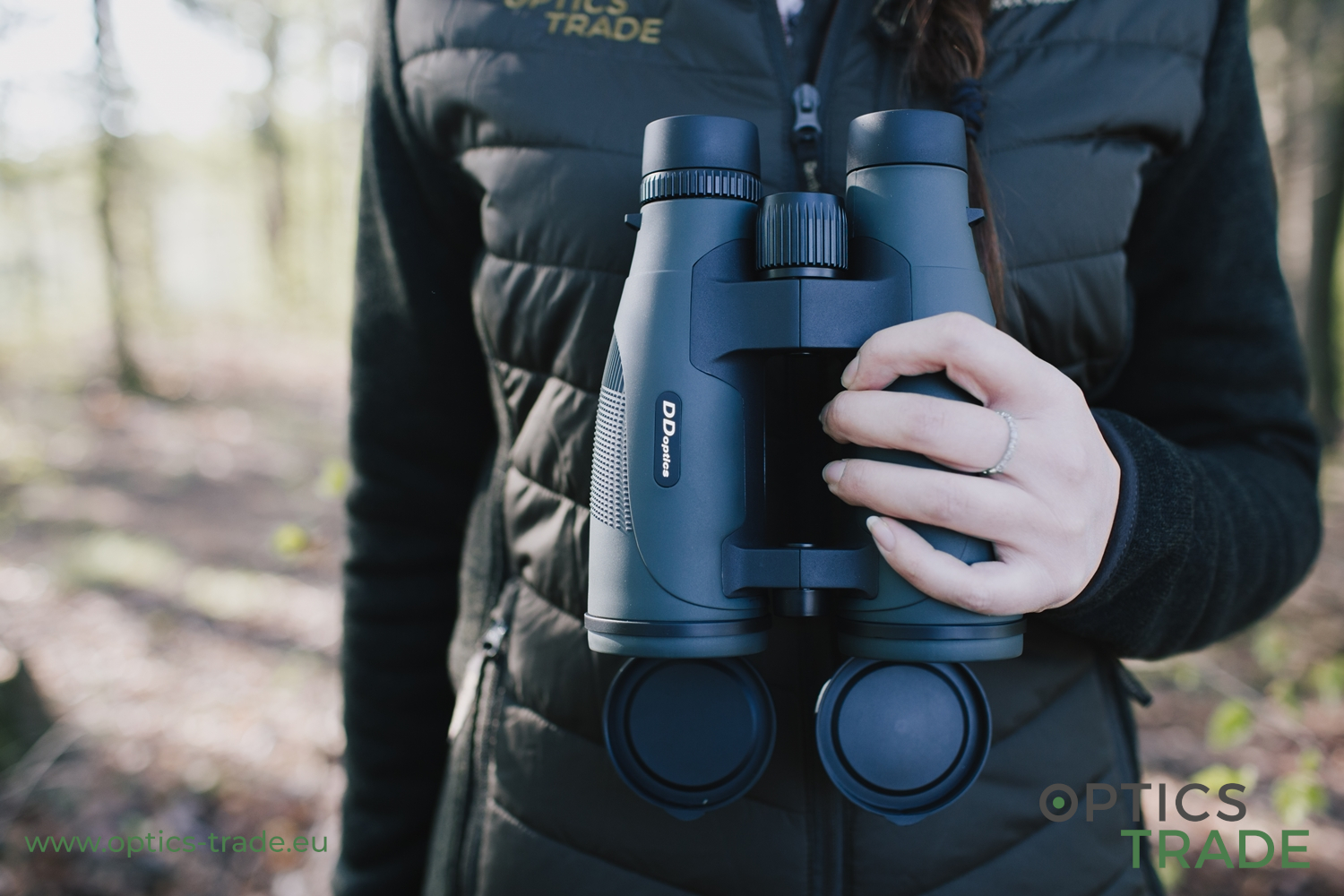
DDOptics Pirschler Gen III 8×56
Pros
- Abbe-Koenig prisms
- great ergonomics
- magnesium housing
- open bridge design
- excellent optics for the price
Cons
- internal reflections
1000 €-1500 €
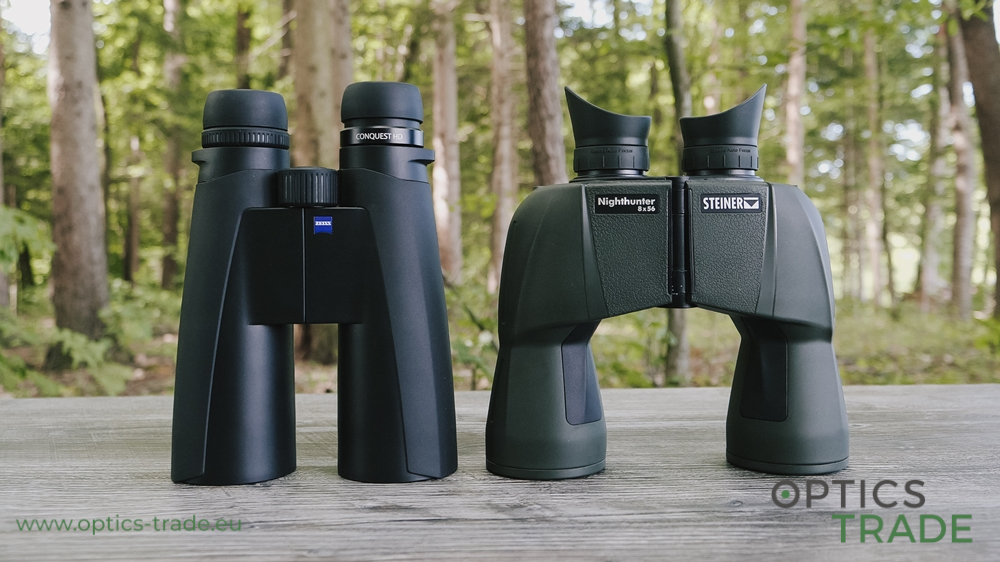
Left to right: Zeiss Conquest HD 8×56 and Steiner Nighthunter 8×56
In this price range, we can already find entry-level models from prestigious European brands in the field of sport optics. These Japanese and Europe-made binoculars have Abbe-Koenig prisms, but some Porro prism models can still be found, and they can be single or open bridge designs.
As the prices increase, aluminium disappears, so these binoculars are made with magnesium housing. Of course, as with the previous price ranges, all are purged with dry nitrogen or argon, which makes them all kinds of -proof: waterproof, fog-proof, you name it.
The eyepiece can be adjusted to three or more different positions, and the coatings the lenses are subject to are also of high quality, and on outer optical surfaces as well. This is great when it comes to water and dust repellency, as well as protection against smaller scratches.
The field of view is better than that with previous price classes, and the image is even sharper and brighter, especially around the edges. Due to the quality construction, we can expose them to extremely low temperatures, up to – 20° C, which is great for your winter trip. Manufacturers also provide a warranty of 10 years, so you will not have to worry about the binoculars getting frostbit.
These binoculars are worth the price, as even the accessories that come with them are of great quality, and sometimes, there is an even larger amount of accessories than with more affordable low-light binoculars. These optics are a great investment, as they are expected to serve you long after you buy them.
Our picks
Binoculars in this price range do not have as much competition as those we mentioned earlier. Zeiss Conquest HD is, without a doubt, the benchmark when it comes to this price class. Nevertheless, Steiner Nighthunter remains the most traditional choice, and traditions are important. Nighthunter is also much lighter and cheaper than Zeiss, but do not let weight stop you from buying either one of them, as both are exceptional.
Steiner Nighthunter 8×56
Nighthunter 8×56 is Steiner’s most favorable pair of binoculars when it comes to low-light use. They prove to be perfect for hunting, as the name suggests. According to Steiner, their anti-reflection coatings can transmit more than 96% of light throughout the visible spectrum. This means that Nighthunter can deliver the brightest image possible even in the worst conditions.
There is almost no condition where these binoculars would not work. They are filled with Nitrogen gas, so Nighthunter is both waterproof and fog-proof. These binoculars also feature Porro prisms, and they have the Typical “Porro Prism Shape” that is immensely comfortable to hold. Steiner Nighthunter 8×56 offers great optical performance for a lower price, due to the Makrolon housing.
The Nighthunter binoculars are quite big and heavy, so they are not ideal for those who travel a lot or specifically require a lightweight instrument. They feature Steiner’s Sports-Auto-Focus system, which means that once you set each eyepiece to match that of your particular vision, no further focusing is necessary. Steiner Nighthunter 8×56 is perfect for those who search for top performance in low-light situations.
Steiner Nighthunter 8×56
Pros
- 30-year warranty
- great service
- amazing eye relief (22 mm)
- wide field of view
- traditional design (personal preference)
- strap attachment solution
Cons
- size
- close focus
- some might not like the eyepieces
Zeiss Conquest HD 8×56
Zeiss Conquest HD 8×56 are extremely elegant Germany-made binoculars that come dressed in Zeiss’s signature black colour in combination with their subtle logo. These binoculars are a perfect companion for low-light observations as they offer superb brightness of the image due to the premium HD lens system and Extra-low dispersion (ED) glass.
What also contributes to their elegant design are the Abbe-Koenig prisms that make them as slim as they can be. This device is beautifully crafted and comes with dazzling black rubber armour. The rubber used is of great quality, making the eyecups more comfortable to look through, and the Conquest easier to hold. Amazing resolution from edge to edge and reduced chromatic aberration delight even the most demanding of observers. With these binoculars, your hunting conquest will, without a doubt, be successful. Zeiss is optically better than Steiner (no other pair of binos is optically as good in this price class) but more expensive and heavier.
Zeiss Conquest HD 8×56
Pros
- build quality
- elegant
- Abbe-Koenig prisms
- currently (2021) the best buy for the price
- no internal reflections
- good image sharpness for the money
Cons
- big and heavy
1500€+

Left to right: Zeiss Victory HT 8×54 and Swarovski SLC 8×56
The highest price range includes premium European brands, such as Zeiss, Leica, Swarovski, and a newcomer in the field of optics, which is Blaser. These low-light binoculars are all made in Germany or in Austria. And by buying such binoculars, you buy a piece of history as well. All these binoculars are the product of long-term development, as to make them, the latest technology is used, as well as coatings of the highest quality. These manufacturers do not have many competitors, as only some are able to manufacture such quality.
Low-light binoculars that cost more than 1500 € are a great option for professional hunters or those, who only wish the best for themselves. Self-care does not have to mean purchasing expensive binoculars, but it sure does contribute, if you ask us. This is because here, we can certainly expect an incredible light transmission rate, some even have it over 95 %. The field of view is great, as well as the sharpness of the image – if we decided to list all the advantages, we might never stop.
The diopter is not placed on one of the eyepieces, but usually on the focusing knob, as it also has a locking function. Usually, the eyepieces can be set to at least 4 positions, which is extremely helpful. These would also not be left behind on your winter trip, as they can withstand temperatures as low as -30° C.
For the exterior, these binoculars have magnesium housing, and the rubber they are coated with is also of high quality. For the interior, these low-light binoculars are still purged with dry nitrogen or argon to prevent internal fogging at low temperatures and to make them waterproof. Such binoculars are all Abbe-Koenig binoculars, as those with a Porro prism do not exist in this price class. The focusing is central. Manufacturers prefer a single-bridge design.
They are the definition of the term “great investment”, as you can sell them for good money even years after purchasing them. These low-light binoculars also have a 10-year warranty however, you can count on manufacturers fixing your optics even when this period is over. On top of their looks, the accessories are also of top-quality: everything points to elegance and class.
Our picks
Now, we have reached the best of the best. In this price class, there is fewer optical differences than in others, which would make the decision increasingly difficult, but we say that Swarovski SLC and Zeiss Victory HT are by far the leading two optics when it comes to low-light use. But because they are so similar, we could not choose a winner optically speaking.
Zeiss Victory HT 8×54
Zeiss Victory HT 8×54 draws in lots of light for excellent observation during night-time, which we can attribute to the Abbe-Koenig prism system and SCHOTT HT glass elements. If low-light hunting is your favorite, Victory HT will astound you.
When it comes to protection, the housing is filled with Nitrogen and sealed to ensure they are waterproof and fog-proof. Zeiss Victory HT feature multi-positioned eyecups with three click-stops for establishing a proper eye-relief for glass wearers, which is an advantage compared to SLC binoculars mentioned down below. Another advantage would be that Victory HT weighs less and is noticeably smaller.
Comparing it to the Swarovski SLC 8×56 listed down below, Zeiss is pricier, but the price also brings along a better, or should we say the best build quality, which can be immediately seen (the barrels, the bridge, etc.) – it is also the smallest and lightest pair of binoculars in this price class. Optically, the two devices are extremely similar. The Victory model comes in a neutral black colour, which makes them elegant and pleasing to the eye. With these low-light binoculars, your victory is right around the corner.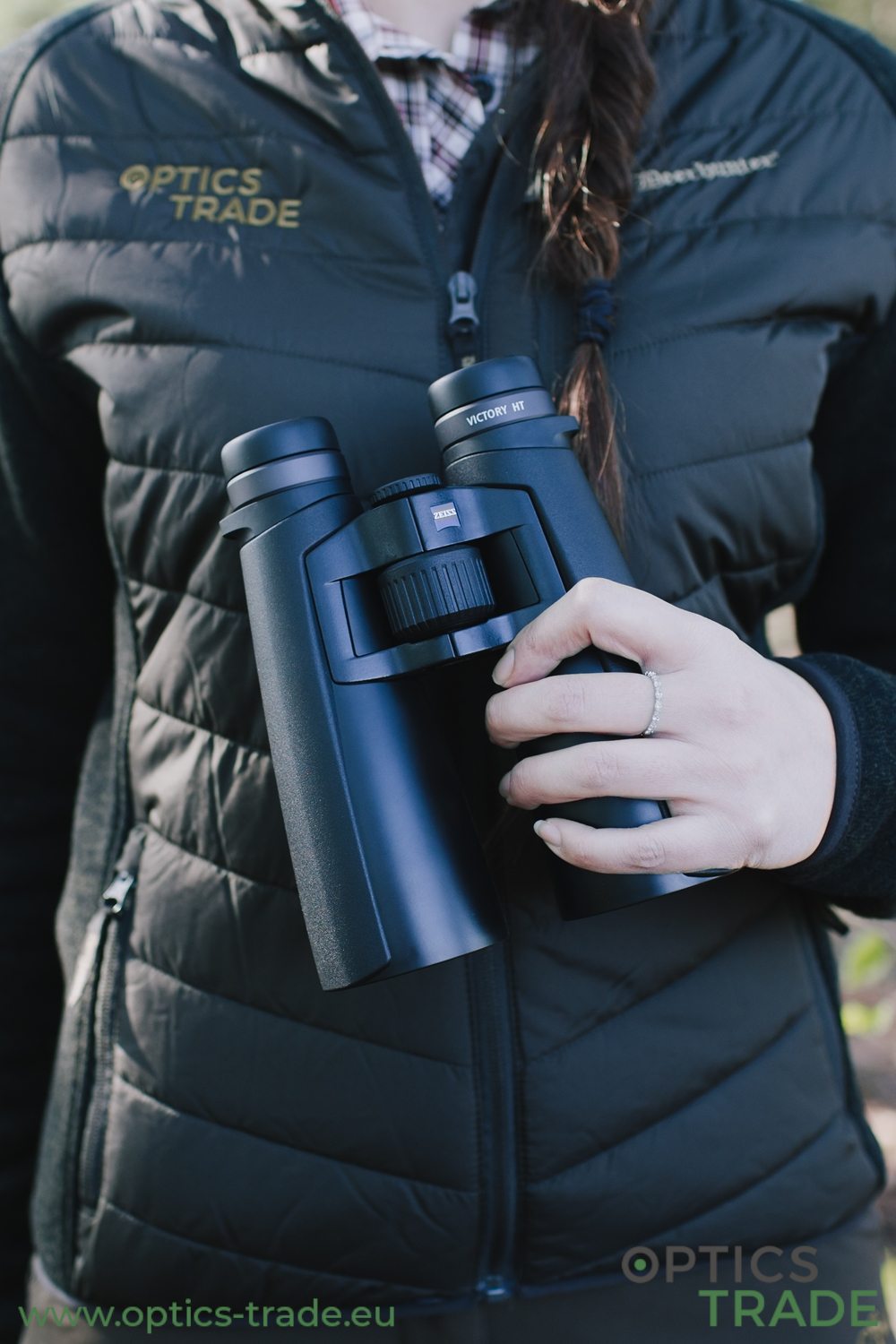
Zeiss Victory HT 8×54
Pros
- extremely bright
- Abbe-Koenig prisms
- immensely elegant
- lightweight
- build quality
- great image sharpness
- position of the focusing wheel
Cons
- price
Swarovski SLC 8×56
Swarovski SLC 8×56 is not your typical girl-next-door type of binoculars, as they offer different elegance than Zeiss’s, but are still extremely elegant and aesthetically pleasing. They are heavier to carry around but still have good ergonomics with a slim design that ensures a comfortable grip. SLC binoculars are dressed in a magnesium body with Swarovski’s typical dark green rubber armour. The differences between the two are minimal, but the SLC is still a bit more affordable than Victory HT.
Swarovski SLC 8×56 features Abbe-Koenig prisms, which ensure very sharp images and a good resolution edge to edge. These binoculars are also equipped with twist-up eyecups, a central focus wheel, and a diopter for adjusting the proper focus. The SLC is purged with Nitrogen and sealed with O-rings making it impervious to water and dust while eliminating internal fogging when it comes to temperature fluctuations.
Unique Swarovski coatings such as Swarotop, Swarodur, and Swarobright on all glass surfaces also greatly increase light transmission and presents lifelike colours without an excess of blue hue. The build quality is better on Zeiss Victory HT, but optically they are extremely similar, and Swarovski is also cheaper. It may still not be for everyone’s wallet, but it surely is one fine piece of optical equipment, as it is optically brilliant. Swarovski never disappoints and with this SLC model, proves once again that they can achieve optical magic. In terms of value for money, these SLC binoculars almost cannot be surpassed.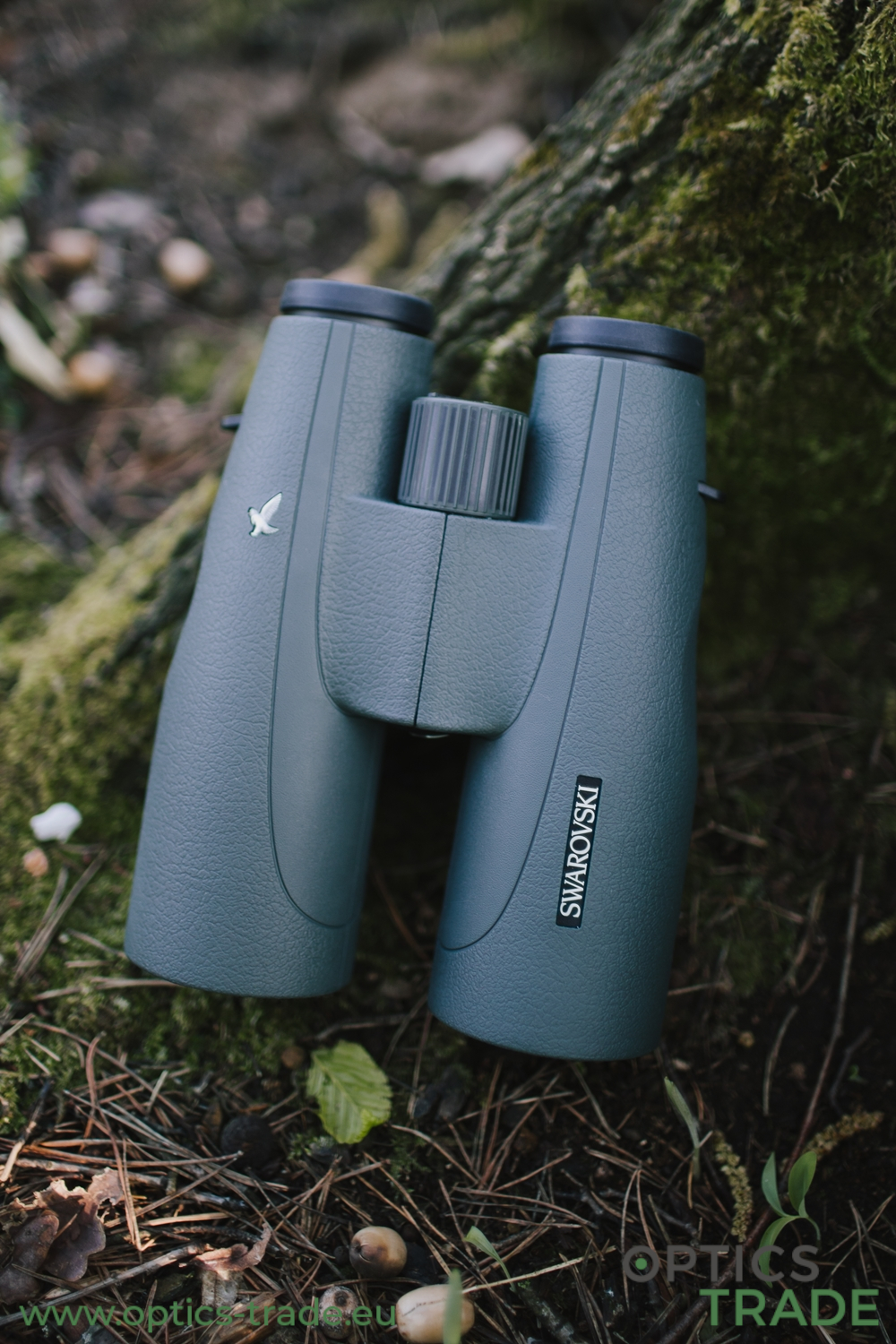
Swarovski SLC 8×56
Pros
- classical, elegant Swarovski appearance
- Abbe-Koenig prisms
- extremely bright
- good elimination of chromatic aberration
- magnesium body
- great apparent field of view and edge sharpness
Cons
- big and heavy
- build quality (better on Victory HT)
Conclusion
Porro prisms used to be a much bigger factor when deciding on a pair of binoculars than they are now, as we saw that Abbe-Koenig prisms work better. Also, they can now be found in binoculars under 1.000 €, which simplifies so many hunters’ decisions. Schmidt-Pechan prisms are no match for Abbe-Koenig prisms in terms of light transmission rate. Low-light binoculars made in Europe remain a rank above others, but we believe that in about a decade, competition will also appear elsewhere.
When it comes to focusing, we were of the opinion that having optics with central focusing would be a huge advantage but in reality, it is not. Yes, having central focusing is great and remains a better choice than focusing separated for each eye, but it is not life-changing and would not shape your hunting as much.
There are many differences when it comes to comparing different price classes. On the low, we were expecting some binoculars from the 1.000 €-1.500 € price class to compete with some more expensive ones, but this was not the case, as the differences were still too noticeable. When comparing binoculars from two price classes, the differences between two neighbouring price classes could be seen in the span of 10 minutes. We were taken back to also notice differences within the price classes themselves, especially at dusk and with binoculars priced 500 €-1000€.
As the days get shorter, we need to face the dark when we go outside in the evenings. And each night as darkness falls, we begin unwinding our day. For many animals though, these same indicators that indicate the end of our day signify it is high time to start theirs. And for us to see them better, low light binoculars, and hopefully our ULTIMATE Low Light Binoculars Buying Guide, come to the rescue, guide you towards the right decision, and help you see better.
Picture Gallery
 Blaser Primus 8×56
Blaser Primus 8×56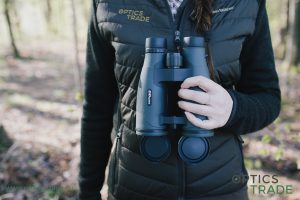 DDOptics Pirschler Gen III 8×56
DDOptics Pirschler Gen III 8×56 DDOptics Pirschler Gen III 8×56
DDOptics Pirschler Gen III 8×56 Delta Optical Extreme 7×50 ED
Delta Optical Extreme 7×50 ED Delta Optical Titanium 8×56 ROH
Delta Optical Titanium 8×56 ROH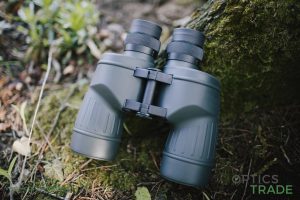 Fujinon 7×50 FMTR-SX-2
Fujinon 7×50 FMTR-SX-2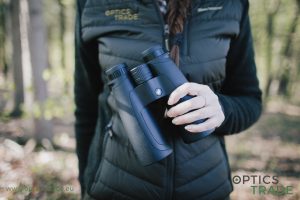 GPO Passion HD 8×56
GPO Passion HD 8×56 Kahles Helia 8×56
Kahles Helia 8×56 Kite Optics Cervus 8×56
Kite Optics Cervus 8×56 Kowa BD 8×56 XD Prominar
Kowa BD 8×56 XD Prominar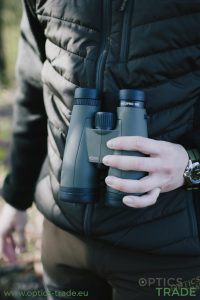 Meopta Meopro HD 8×56
Meopta Meopro HD 8×56 Minox X-Active 8×56
Minox X-Active 8×56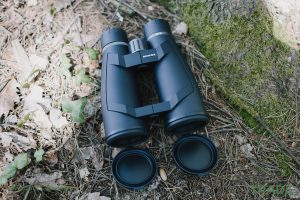 Minox X-HD 8×56
Minox X-HD 8×56 Nikon Monarch 5 8×56
Nikon Monarch 5 8×56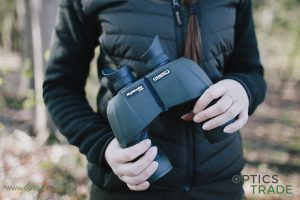 Steiner Nighthunter 8×56
Steiner Nighthunter 8×56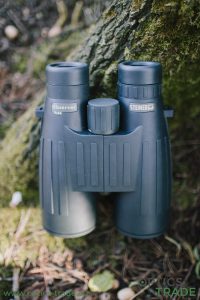 Steiner Observer 8×56
Steiner Observer 8×56 Steiner Ranger Xtreme 8×56
Steiner Ranger Xtreme 8×56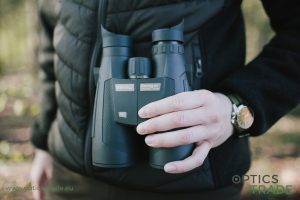 Steiner Ranger Xtreme 8×56
Steiner Ranger Xtreme 8×56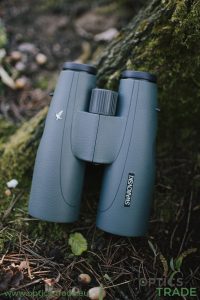 Swarovski SLC 8×56
Swarovski SLC 8×56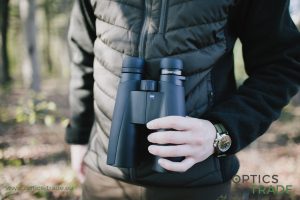 Zeiss Conquest HD 8×56
Zeiss Conquest HD 8×56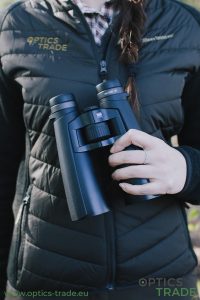 Zeiss Victory HT 8×54
Zeiss Victory HT 8×54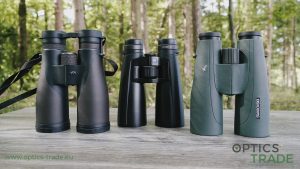 Left to right: Blaser Primus 8×56, Zeiss VictoryHT 8×54
Left to right: Blaser Primus 8×56, Zeiss VictoryHT 8×54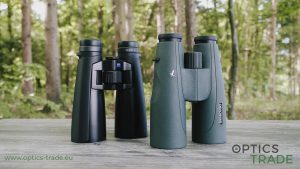 Left to right: Zeiss Victory HT 8×54 and Swarovski SLC 8×56
Left to right: Zeiss Victory HT 8×54 and Swarovski SLC 8×56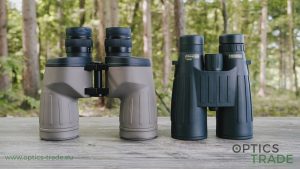 Left to right: Delta Optical Extreme 7×50 ED and Steiner Observer 8×56
Left to right: Delta Optical Extreme 7×50 ED and Steiner Observer 8×56 Left to right: Delta Optical Titanium 8×56 ROH, Delta Optical Extreme 7×50 ED and Steiner Observer 8×56
Left to right: Delta Optical Titanium 8×56 ROH, Delta Optical Extreme 7×50 ED and Steiner Observer 8×56 Left to right: DD Optics Pischler gen III 8×56, GPO Passion 8×56 and Kite Optics Cervus 8×56 HD
Left to right: DD Optics Pischler gen III 8×56, GPO Passion 8×56 and Kite Optics Cervus 8×56 HD

 Left to right: Zeiss Conquest HD 8×56 and Steiner Nighthunter 8×56
Left to right: Zeiss Conquest HD 8×56 and Steiner Nighthunter 8×56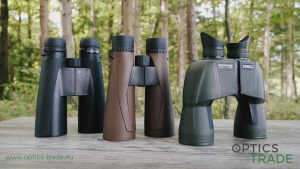 Left to right: Zeiss Conquest HD 8×56, Kahles Helia 8×56 and Steiner Nighthunter 8×56
Left to right: Zeiss Conquest HD 8×56, Kahles Helia 8×56 and Steiner Nighthunter 8×56
Glossary
Magnification
Magnification is the magnifying power of an instrument that enlarges the viewing image and makes the observed object seem bigger. For example, with a 10x magnification factor, we see objects 10x closer, which means that if the target is 100 m away and we use a 10x magnification, it means that is the same as watching it with the naked eye 10 m away. When choosing the right magnification for fixed magnification optical products, practice shows that the most useful magnification is between 7x and 10x, where average people seem to handle optics without too much hand tremor.
Source: Zeiss
Fixed Magnification
Optical products with fixed magnification are designed in a way that they allow only one magnification setting. Due to the smaller number of lenses used in their construction, they are optically brighter. The number of lenses contributes to the smaller size and lighter weight in comparison to optics with variable magnification. Most binoculars tend to have fixed magnification, whereas, with riflescopes, it is getting rarer each year. Normally, this kind of optical products are easier to use and are also cheaper. They also offer better optical performance, especially in terms of the light transmission rate.
Variable Magnification
Variable magnification simply means that the optical product is designed in a way where you can change the magnification. This consequently changes the viewing angle, where a higher magnification equals a narrower viewing angle, and a lower magnification means a wider viewing angle. Variable magnification adds to the versatility and general usefulness of the optics.
Lens Diameter
The second number in the product’s name represents the lens diameter. For example, 10×42 binoculars have a lens diameter of 42 mm. It is known that the bigger the lens, the more light goes through and the image we see is brighter. All of this, however, also depends on the magnification and quality of a certain optical product. Although a bigger lens diameter in binoculars is better, the size adds up on the weight, making it heavier and more difficult to handle. The most common lens diameters are 24 mm, 42 mm, 50 mm, and 56 mm.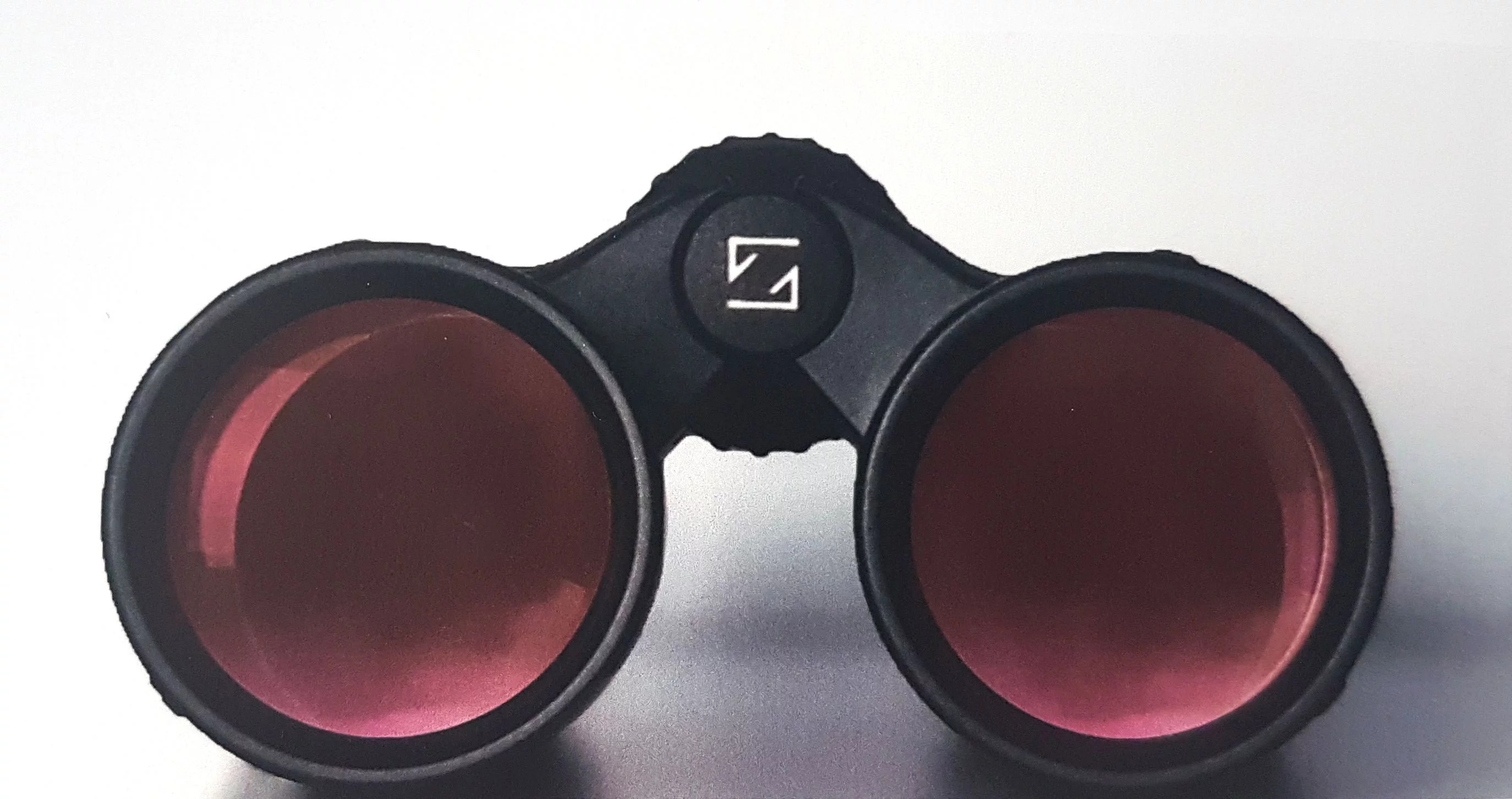
Source: Zeiss
Exit Pupil
The exit pupil is a circle from which the light is being transferred to your eye through the optical product. When you hold the optics a bit further away from your eyes towards the light, the exit pupil can be seen as a bright circle in the center of each eyepiece. The larger the exit pupil the more light can reach the eye and the image appears brighter. This is why the exit pupil plays an important part when it comes to optical products in poor light conditions at dawn or dusk. The size of the exit pupil also determines how comfortable viewing through an optical product really is. An important factor is also the size of the eye box, which is a space where the eye still sees an entire picture without any tunnel vision or blurry edges. A bigger eye box means more flexibility of the eye position and therefore a more comfortable viewing experience because the eye can move in several directions within the eye box and still obtain a full image.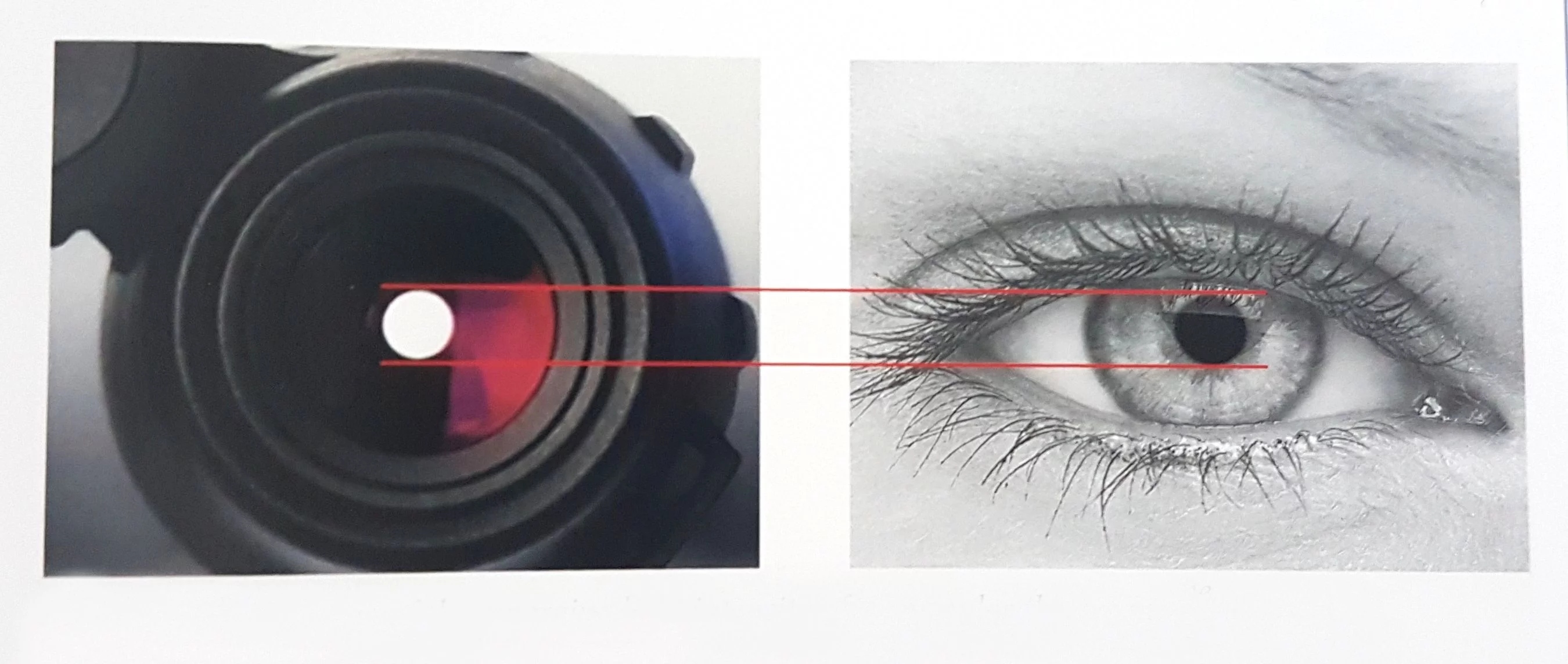
Source: Zeiss
The diameter of the exit pupil is calculated by dividing the lens diameter with the magnification power. For example, 8×50 binoculars have an exit pupil with the diameter of 6.25 mm.
To ensure a brighter image, the eye pupil in low light conditions has to be at least as big as the exit pupil. This way, there is no loss of light, and the image is as bright as it can be. However, the maximum diameter of the eye pupil depends on a person’s age. At night, children’s eye pupils can widen up to 7 mm but with aging, they decrease to a maximum of 4 mm. So, if the observer’s pupils can only widen up to 4 mm, the 7 mm exit pupil cannot be fully utilized. It may contribute to a more comfortable viewing, but not to a brighter image.
In daylight, when the eye pupil is as wide as 3 mm, all optics with an exit pupil bigger than 3 mm are equally bright. For example, 8×30 binoculars with a 3.75 mm exit pupil are no brighter than 8×56 binoculars with a 7 mm exit pupil. Those with a width of 7 mm, however, are more comfortable to use since they are less sensitive to the eye position (they have a bigger eye-box).
Field of View
The field of view is an area the observer sees when looking through the optical product. Although it primarily depends on how the eyepiece is built, it is also hugely affected by magnification. If you look through two binoculars of the same model but with a different magnification, you can notice that the one with a lower magnification factor will have a wider field of view. So, when comparing binoculars, you must compare the ones with the same magnification. With binoculars, spotting scopes, and other optical products it is measured at 1000 m.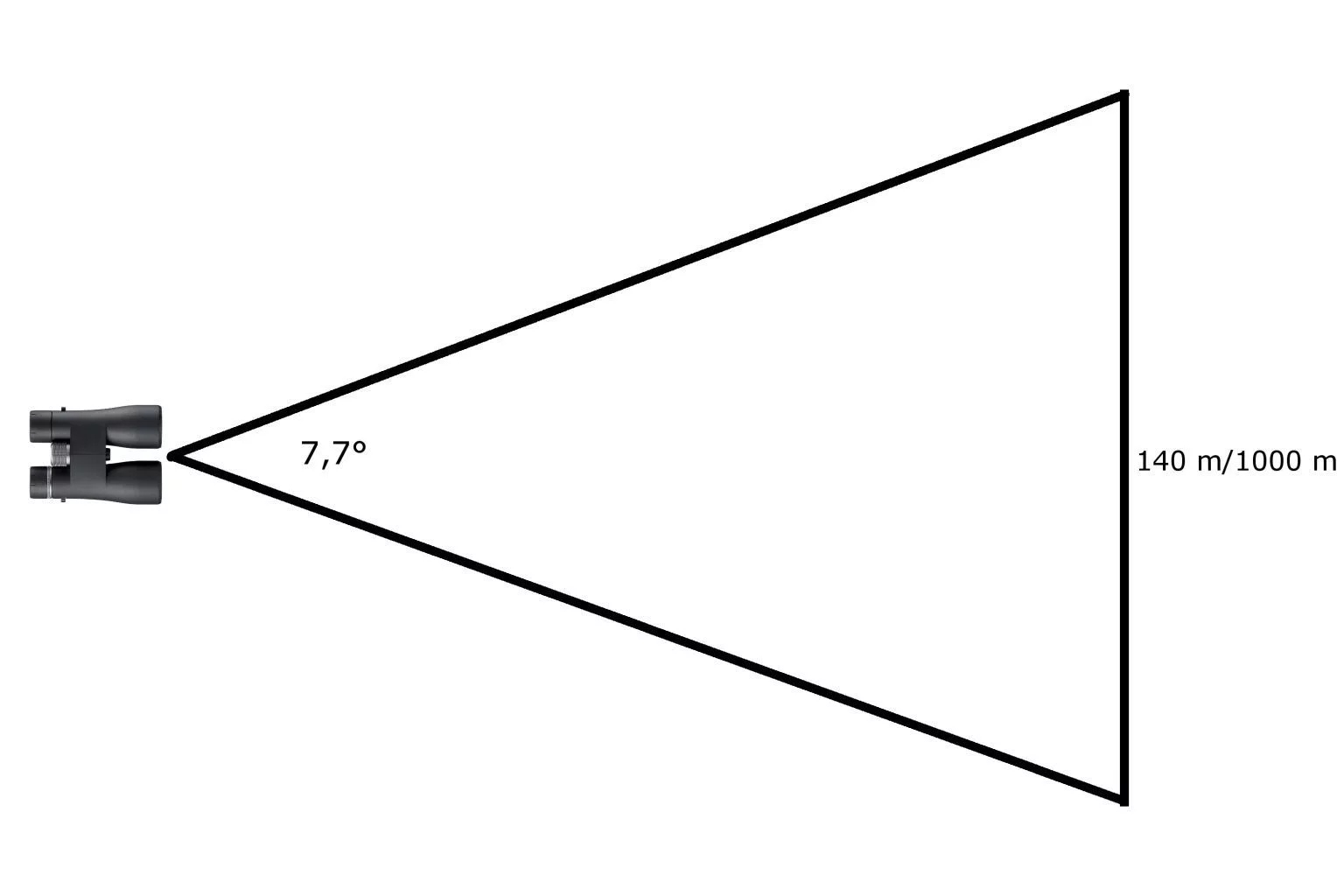
Source: Zeiss
With binoculars, a field of view with more than 140 m at 1000 m distance is considered a wide-angle one, while with riflescopes, a wide angle refers to a field of view over 38 m at 100 m. A wide angle is particularly useful when bird watching. It is also important to mention that the size and lens diameter of optical products are not indicators of their field of view – bigger binoculars do not automatically mean a wider field of view.
The field of view can be expressed in two values – degrees or meters.
Degrees:
One degree is 17.5 m at 1000 m / 1.75 m at 100 m.
If you divide the field of view given in meters by 17.5 you get the field of view in degrees.
Meters:
If you multiply degrees with 17.5 you get the field of view at 1000m.
Apparent Field of View
The apparent field of view is a value in degrees that represents the viewing angle of an image the observer sees through the eyepiece. Two binoculars that share the same magnification, lens diameter, and field of view, do not necessarily have the same apparent field of view, because it depends on the structure of the lenses inside an eyepiece. It is simply a subjective impression of the field of view.
The apparent field of view also depends on the eye relief distance. A shorter eye relief also means a wider apparent field of view. But when comparing two different binoculars with the same eye relief, the one with the larger eye lens in the eyepiece will have a larger viewer field.
It can be calculated by multiplying the actual field of view with the scope’s magnification. A higher value is better as it makes the image appear wider and larger.
Source: Nikon
Prism Types
Most modern binoculars are made with a transparent optical element with flat, polished surfaces that refract light. Prisms in binoculars also determine their size, shape, optical features, and play an important part in providing image quality of binoculars. However, prisms are often a neglected factor in the process of buying binoculars. There are many types of prisms present that normally determine the purpose of certain binoculars – whether they are for hunting, marine, bird watching, etc.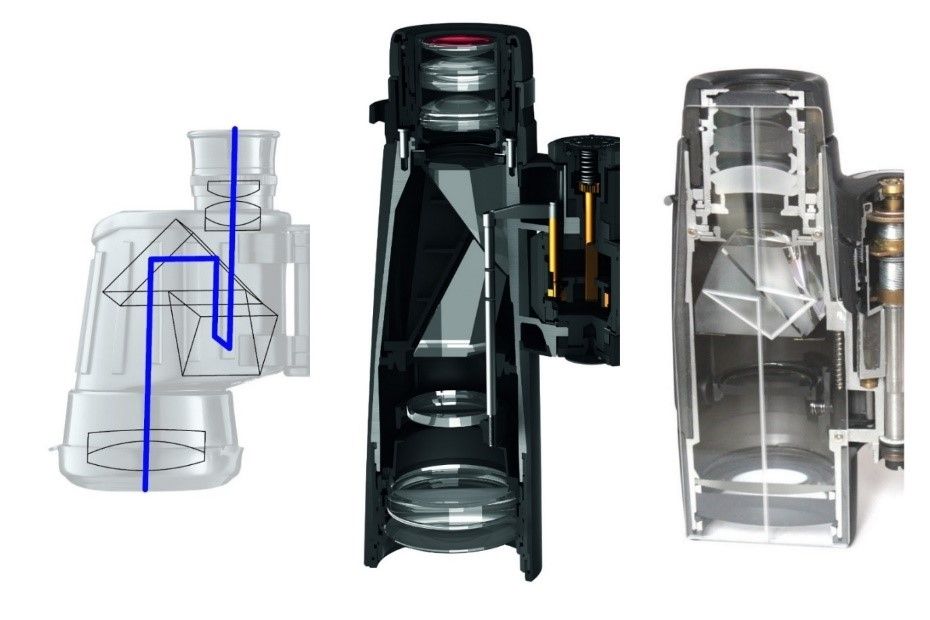
Source: Lovec
Porro Prism Binoculars
Binoculars that have Porro prism (named after Italian physic Ignazio Porro) in their optical construction were predominantly the first type of binoculars on the market. In the last couple of decades, binoculars with Roof prisms (either Schmidt-Pechan or Abbe- Köning) became more popular, due to their compactness and water tightness. This traditional arrangement of binoculars provided by Porro-prisms makes objective lenses stand further apart and thus offer a higher light transmission rate. Images are not only brighter and sharper but also have a better depth of field, offering realistic 3D images and a wider field of view.
Many Porro prism binoculars also have a focusing mechanism separated for each eye, which can be very useful in low-light situations, when observing at dusk, and dawn. Even though Porro prism binoculars are becoming rarer, this traditional arrangement makes them more affordable due to less expensive manufacturing. But a wider design makes them heavier and more difficult to hold. They are also not as watertight and rugged, which provides a less secure grip. Another disadvantage of Porro prism binoculars is the lack of adjustable eyepieces, which in most cases leads to problems when using the binoculars with glasses.
Abbe/Koenig Roof Prism & Schmidt/Pechan Roof Prism Binoculars
Binoculars with roof-like prisms in their optical construction provide a compact design due to the straight-line position of eyepieces and objective lenses. They are more expensive due to complex manufacturing and provide many advantages for more demanding users. They are less sensitive to abrasions and are incredibly impervious to water and dust entering the construction. They are usually purged with nitrogen or argon gas, which also helps to eliminate internal glass fogging.
Compared to Porro prism binoculars, they are more likely to withstand extreme weather conditions. The very good ergonomic design of this straight-line construction makes them less difficult to hold and immensely eases their portability. But compared to Porro prism binoculars, this construction makes light transmission less permeable and thus provides darker and less sharp images.
The main difference between both types of binoculars with Roof prisms is that those with Schmidt – Pechan prisms tend to be smaller and less expensive, while those with Abbe – Köning prisms tend to have better light transmission rate and a longer construction.
Lens Coatings
Optical products have many lenses in their housing. With each lens, about 5% of the light that passes through is lost. This can be solved with the application of coatings on glass surfaces. Through the years, the process of applying the coatings has changed. At first, they used only one layer, where the reduction of the loss was to 2% per surface. Today, they use multiple layers of coatings where there is minimal loss of light, namely 0.1% per surface. The best binoculars even have 95% of the light transmitted to the eye, through all their lenses.
With the increasing transmission of the light, the coating is also important as a protectant of the optical glass and to ensure the true color fidelity, so the colors are the same when entering as they are when exiting the binoculars/a riflescope. Above all, coatings also increase the image quality because all the light bouncing around on the inside can cover up detail and blur out colors.
The process of applying coatings has to be precise, otherwise, it can lead to a hazy and blurred image. Coatings must be spread evenly and thin to ensure the best quality. The better the coatings, the more expensive the optical product.
Lens coatings are as important as the quality of the lenses themselves. You can easily check whether your optical product has coatings – if you look at the reflection and it shows multiple colors such as purple, green, or yellow the lenses are definitely coated. On the opposite, lenses with no coatings have a clear reflection without showing any colors.
There are many different ways of applying lens coatings:
- Coated: where one or more glass surfaces are coated with one thin anti-reflective layer.
- Fully coated: where all glass surfaces are coated in one thin anti-reflective layer.
- Multicoated: where one or more glass surfaces are coated in multiple layers. Light transmission is more than 75%.
- Fully multicoated: where all glass surfaces are coated in multiple layers. Light transmission is more than 85%.
- Outer surface coating: coating on the outer glass surface which protects the lens from external dew (especially in the winter), partially from dirt and other impurities. They can have different names, depending on the manufacturer (LotuTec, Swarodur, AquaDura)
Focusing system
Depending on the purpose of use, there are two focusing systems available when it comes to binoculars. The most common is a central focusing system, which is present in every pair of binoculars with roof prisms almost without an exception. The other less occurring system is focusing separated for each eye, which is the most useful in marine (because of the water-resistance) and extreme low light situations. Binoculars with this kind of focusing system have an advantage in setting the right focus only once for each eye, which is especially useful when viewing in the dark where it is not necessary to set the focus again.
With central focusing, it is often difficult to focus the image in the dark, because there is not enough light to see whether the object is sharp or not.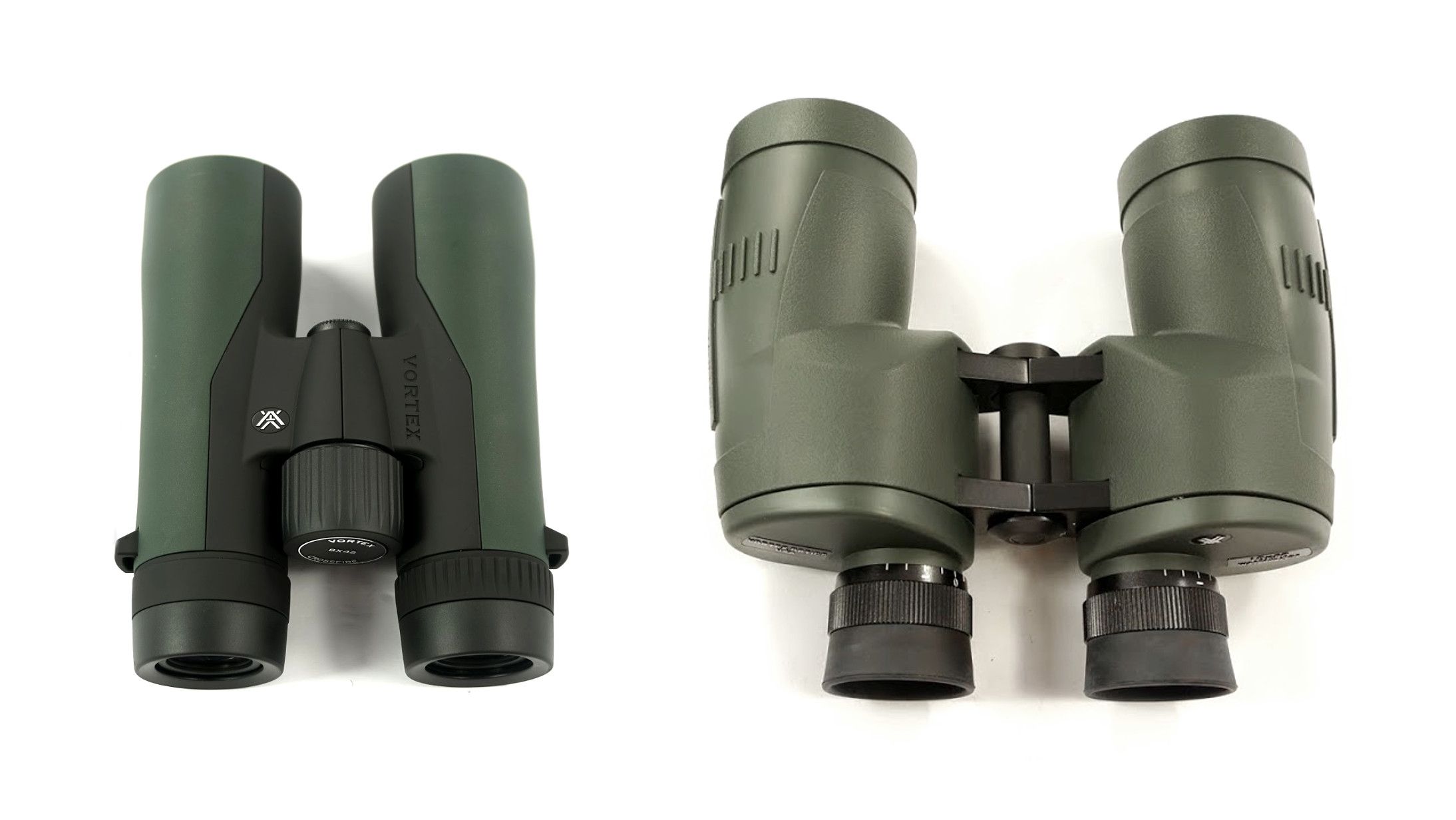
Binoculars with central focusing (left) and binoculars with individual focusing (right)
Source: Optics Trade
Binoculars With Central Focusing
Binoculars with central focusing have a central wheel that is able to provide perfectly sharp images. With a central focusing knob, you adjust the focus of both barrels at the same time, moving the lenses simultaneously. When choosing between binoculars with a central focusing system, it is important to look for their design and performance. Depending on the manufacturer, some binoculars provide sturdier focusing and some very smooth focusing, which is especially suitable for dynamic situations.
The focusing also varies from binos to binos. It takes more time for setting a proper focus with a long focusing throw, than with the ones with a shorter one. When it comes to ergonomics, most binoculars provide a central knob with different bulges for a better grip, which is very convenient when wearing gloves. Since the central focusing wheel does not eliminate differences in both eyes, a diopter on the upper side of the barrel is included.
Binoculars With Individual Focusing (Focusing Separated for Each Eye)
An individual focusing system provides focusing for each eye separately. On the upper side of both barrels lie focusing rings – diopters, with the numbers for setting a proper focus by moving lenses individually. The majority of binoculars use the central rotating knob, so this arrangement is not that frequent and is most commonly found on Porro prism binoculars. The individual focusing system has many different commercial names like sports autofocus, permanent focus, or simply autofocus.
The main characteristic of this system is that you can set them only once and afterward, the eyes focus on different distances by themselves. This can be a significant advantage in low-light situations when there is not enough light for precise focusing with a central knob. Binoculars of this type are also incredibly watertight and thus very likely to appear on most marine binoculars. There are, however, some disadvantages of such a focusing system compared to more conventional central focusing. The close focusing distance is usually bigger and most binoculars with individual focusing do not offer adjustable eyepieces for those wearing eyeglasses.
Fog-Proof Binoculars
Optical products are often filled with dry gas to prevent the condensation on the inside of the housing when exposing them to extreme temperatures. If there is even a slight sign of air inside, there is a certain % of moisture present. Usually, they are filled with either argon or nitrogen gas, which have the same effect – to prevent moisture and internal fogging without affecting the optical properties. In addition, these gases also prevent the formation of fungus which would destroy the optics. Internal dewing was the biggest problem in older binoculars when exposed to lower temperatures because they were not watertight and contained air. Newer binoculars are therefore all airtight and filled with dry nitrogen or argon.
Waterproof Binoculars
The waterproof feature is made to keep the optical products sealed and protected from water or dust. Such products are suitable for marine, hunting, hiking, or use in extreme humidity. Even if you are not planning on using them in such situations, it is a good feature to have in case of heavy rain or dust. Waterproof optical products are typically sealed with O-rings.
All optical products that are fog-proof are also waterproof because they have to be properly sealed to keep the dry gas inside. Yet not all waterproof products are also fog-proof, as the air inside the product is not necessarily replaced with dry nitrogen or argon.
You should be careful not to confuse waterproofness with optics being weather-resistant as they are designed to be protected only against light rain and are not fully sealed. Slightly better waterproofing of binoculars can also be ensured with an individual eye focusing mechanism.
Closest Focus Distance
The closest focus distance is an important value when observing butterflies, moths, or plants at a really close distance. It represents the nearest distance where the viewing object can still be in focus. With binoculars, an excellent viewing distance is from 1.5 m below. If you are not particularly interested in observing objects at a close range, this is an irrelevant factor when choosing a new pair.
Twilight Factor
In the past, the twilight factor was an important value in determining the brightness of the optics. The manufacturers were using the same kind of technology and materials of the lenses therefore, the optics were comparable. Nowadays, they use different types of lenses and modern coatings, so the twilight factor has lost its meaning because the brightness of the optics depends more on the quality of the coatings than on the twilight factor.
The twilight factor is calculated by the square root of multiplying the magnification and the lens diameter.
The twilight factor of 8×42 binoculars is a square root of 336, meaning 18.33. All the binoculars with this kind of magnification and a lens diameter have the same twilight factor, but not the same brightness. If you look through an old pair of binoculars made in the 1950s and a new pair with the same magnification and lens diameter, you could see the difference in brightness, even though they share the same twilight factor. The newer pair is significantly brighter due to better lens materials and coatings.
Though manufacturers still specify the twilight factor, we recommend you ignore it as it is not important.
Relative Brightness
Relative brightness is a calculation of how bright the image should be when viewed through binoculars. It is presented as a square value of the exit pupil. 10×50 binoculars have an exit pupil value of 5.0 (dividing lens diameter with magnification). The square of 5.0 gives us a value of relative brightness which is 25.0. As the relative brightness value increases, so does the brightness of the image. On the opposite, the lower the value, the darker the image.
In the past, relative brightness was an important factor in determining the brightness of the optics. The manufacturers were using the same kind of technology and materials of the lenses therefore, the optics were comparable. Nowadays, they use different types of lenses and modern coatings, so the relative brightness has lost its meaning because the brightness of the optics depends more on the quality of the coatings than on the relative brightness.
Light Transmission
Light transmission specifies the amount of light that is let through. Each crossing through each lens means a certain loss of light (0.1% with best coatings, up to 5% without coatings). A higher light transmission rate is very important when using optics at dawn or twilight. Good optics normally have a light transmission rate up to 90%, whereas top-notch ones have even 95% and more light is let through.
Although the quantity of light reaching the eye depends on the size of an exit pupil, light transmission determines the transparency of the lenses, whether the image is dark and cloudy or bright and clear.
Uncoated glass reflects about 5% of the light (entry-level price range), a single coating reduces the reflectivity to approx. 1.5% (middle price range), multi-coating reduces the reflectivity to approx. 0.1 to 0.2 % (premium price range)
Source: Zeiss
Light transmission can be increased by applying different coatings on glass surfaces. However, it depends on the coating type and the number of layers. Multi-layered coatings also mean a higher light transmission.
Diopter Range
The diopter ring is present in the central focusing system on each of the barrels near the eyepiece, where you can correct the difference in the prescription of the left and right eye individually. Once you have set the right value, you can focus the image using just the central focusing ring. If you are wearing glasses, the diopter value should be set to 0, because the differences in your eyes are already corrected in your glasses.
Source: Nikon
To see a sharp image without wearing glasses, you can easily set the diopter by looking with the bare eye, turning the ring, and adjusting sharpness. So, when looking with both eyes your image should appear sharp. If you have astigmatism, the diopter adjustment cannot correct it – you will still need your glasses and the diopter set to 0 to see sharp images.
Author: Maruša Justinek, www.optics-trade.eu





